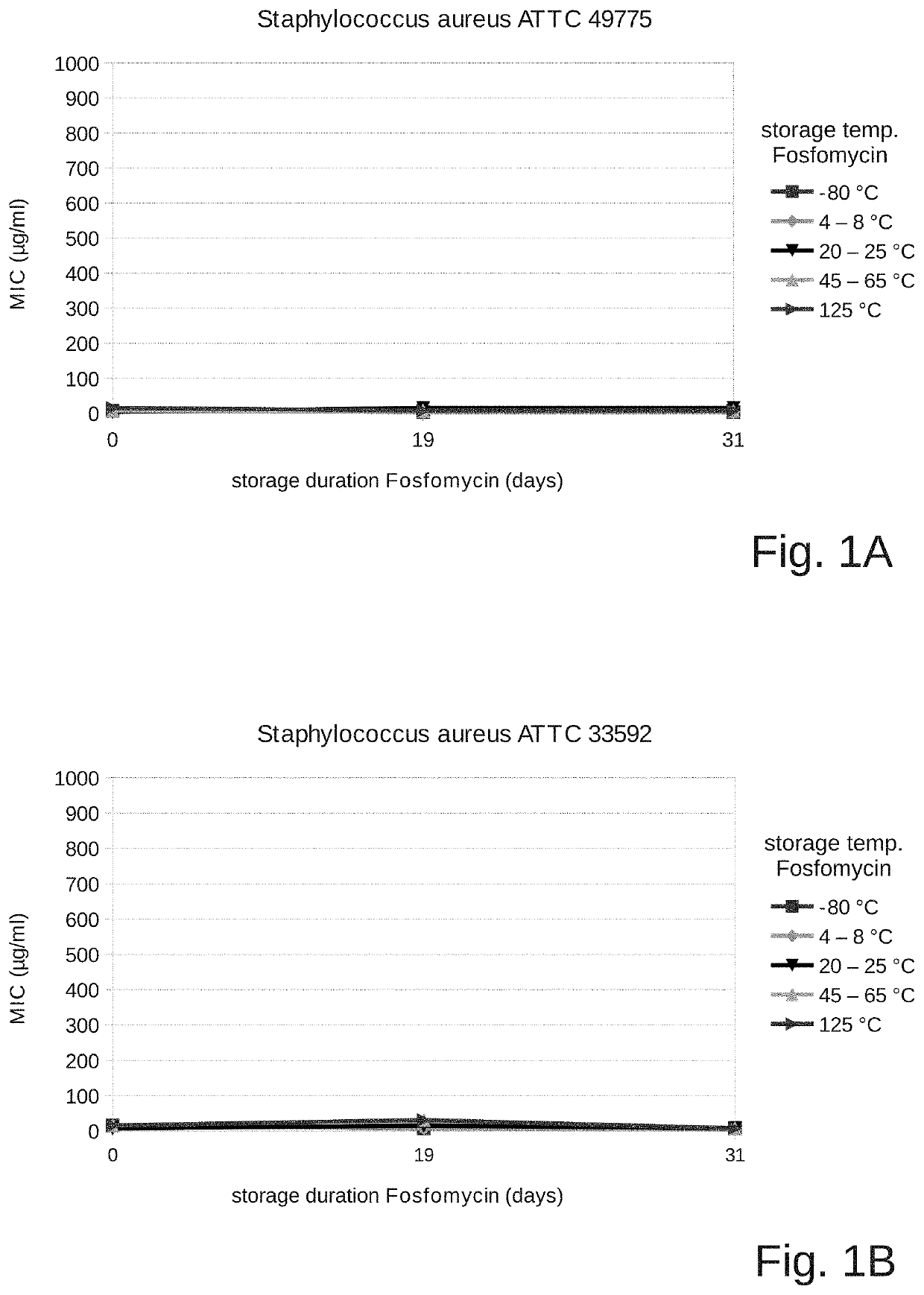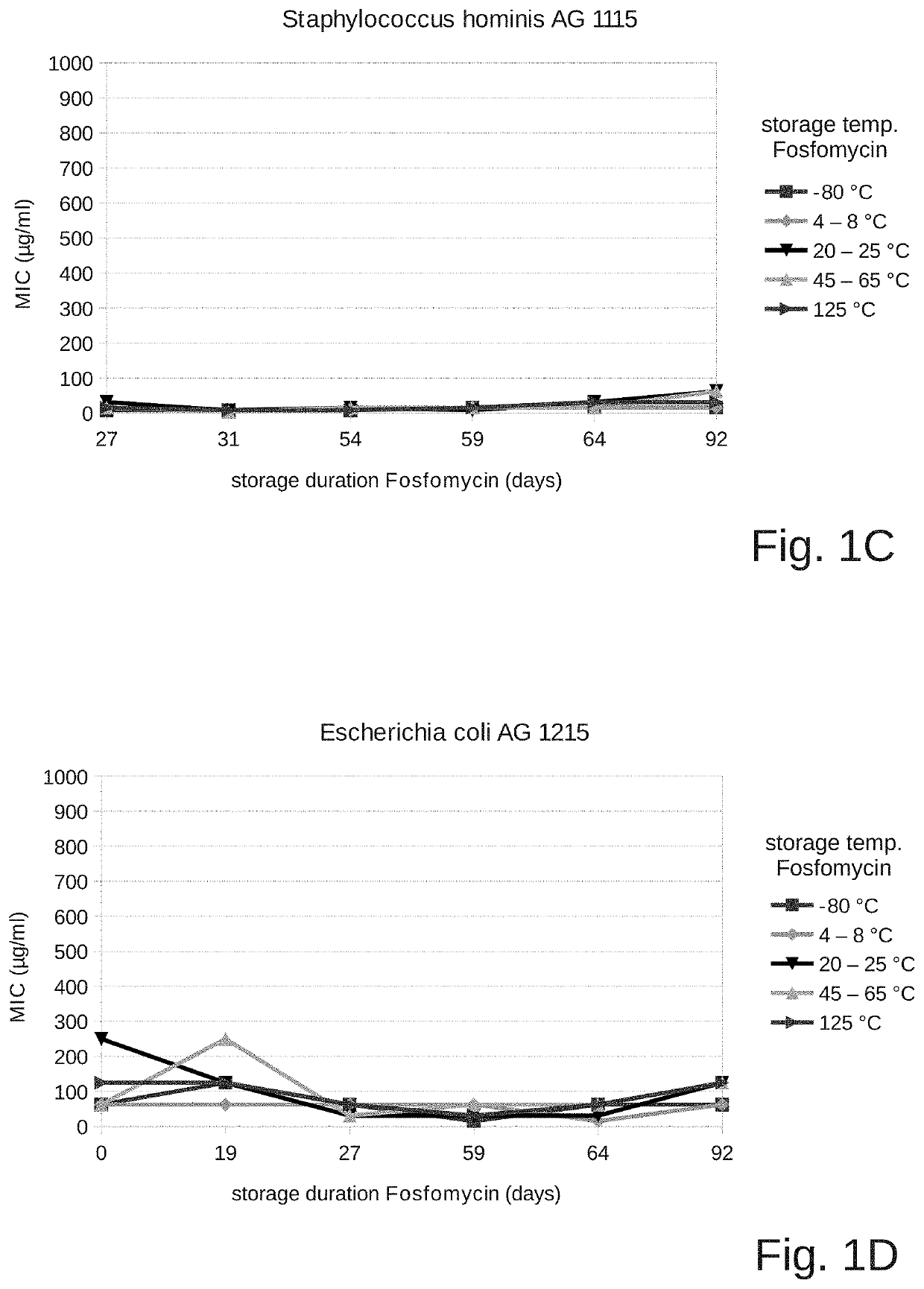Fosfomycin formulation for parenteral administration
a technology of formulation and parenteral administration, which is applied in the direction of pharmaceutical non-active ingredients, packaging types, special packaging, etc., can solve the problems of complex technology, difficult production and administration, and inability to administer fosfomycin which is dissolved in water parenterally, etc., to achieve the effect of convenient production and administration
- Summary
- Abstract
- Description
- Claims
- Application Information
AI Technical Summary
Benefits of technology
Problems solved by technology
Method used
Image
Examples
example 1 — preparation
Example 1—Preparation
[0113]In 500 L of water for injection in accordance with Ph. Eur. (8th edition), 26.4 kg of fosfomycin disodium (corresponding to 20 kg of fosfomycin) and 500 g of succinic acid are dissolved under sterile conditions. This solution is filled under sterile conditions in 5000 infusions bottles (single volume 100 ml). The infusion bottles are each capped with a suitable rubber stopper and packaged at 10 pieces per box.
[0114]The pH of this solution is 7.5. The solution contained in the infusion bags is ready to use for intravenous administration and is storable at room temperature for months. When fosfomycin produced by fermentation is used, a sterile filter is inserted upstream in the final fill into the infusion bottle under sterile conditions.
example 2
Studies
[0115]The objective of the present investigation was to find out whether the antimicrobial activity of fosfomycin with a pH suitable for intravenous administration is maintained in a solvent suitable for intravenous use. For this, fosfomycin disodium (14.5 mmol sodium / g) and succinic acid were used to adjust the pH (0.025 grams of succinic acid per gram of fosfomycin).
[0116]The pH of this solution was 7.5.
[0117]A stock solution of 4 g of fosfomycin disodium and succinic acid (0.025 grams of succinic acid per gram of fosfomycin, corresponding to about 3 g of fosfomycin) in 10 ml distilled water was prepared and divided into 5 cryotubes at 2 ml each, and the solution was exposed at different temperatures as follows:
[0118]Aliquots of 2 ml of the sample were stored at −80° C., at refrigerator temperature (2-8° C.), at room temperature (20-25° C.), and at 45-65° C. until the test end. Another 2 ml of the stock solution were stored at refrigerator temperature (2-8° C.) and autoclav...
example 3
on of the Combination Preparation of Fosfomycin and Terbinafine
[0124]26.4 kg of fosfomycin disodium (corresponding to 20 kg of fosfomycin), 500 g of succinic acid and 0.5 kg of terbinafine HCl are dissolved under sterile conditions in 500 L of water for injection in accordance with Ph. Eur. (8th Edition). This solution is bottled under sterile conditions in 50,000 bottles (single volume: 10 ml). The bottles are each sealed with appropriate rubber stoppers and are packaged into a box at 50 pieces each.
[0125]The solution contained in the bottles is ready to use for administration by inhalation as an aerosol and can be stored at room temperature for months.
PUM
| Property | Measurement | Unit |
|---|---|---|
| pKa | aaaaa | aaaaa |
| pKa | aaaaa | aaaaa |
| pKa | aaaaa | aaaaa |
Abstract
Description
Claims
Application Information
 Login to View More
Login to View More - R&D
- Intellectual Property
- Life Sciences
- Materials
- Tech Scout
- Unparalleled Data Quality
- Higher Quality Content
- 60% Fewer Hallucinations
Browse by: Latest US Patents, China's latest patents, Technical Efficacy Thesaurus, Application Domain, Technology Topic, Popular Technical Reports.
© 2025 PatSnap. All rights reserved.Legal|Privacy policy|Modern Slavery Act Transparency Statement|Sitemap|About US| Contact US: help@patsnap.com


